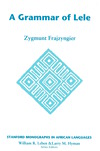

|
|
|
|

A Grammar of LeleInadvertently, African languages have been neglected by many of those performing research in the field of linguistics. In an attempt to expand and diversify the research base of African languages, a handful of linguists have begun to focus their attention on lesser-known languages. A Grammar of Lele is the first book ever written on Lele, an endangered language spoken in the Republic of Chad. The language belongs to the Chadic branch of the Afro-Asiatic family, whose other members are Semitic, Egyptian, Cushitic, Omotic, and Berber. This book explores the use of vowel harmony as a means of coding categories of morphemes. Suffixes undergo vowel harmony rules; clitics do not, and must occur in specified contexts; free morphemes, which also do not undergo vowel harmony rules, have relatively free distribution. The language has also an intriguing reference system, complex sentence structures, and the coding of backgrounding. The study of these and other categories and structures not encountered in the more familiar Indo-European languages will appeal to lovers of languages and linguistics. , professor of linguistics at University of Colorado, has published grammars and dictionaries of several African languages, and comparative studies in African linguistics. He has also published numerous theoretical articals in journals and collected volumes on linguistics. Contents
1 Introduction 2 Phonology 3 The Structure of the Noun Phrase 4 Coding Arguments 5 Adjuncts 6 Tenses 7 Aspect and Pragmatically Dependent Causes 9 Equational Clauses 10 Possessive, Locative and Existential Clauses 11 Reference Systems 12 Modality 13 Interrogative Clauses 14 Negation 15 Focus Constructions 16 Topicalization 17 Backgrounding 18 Pararactic and Conjoined Clauses 19 Complementation 20 Complementation through the Referential Marker 21 Complementation through Nominalization 22 Adjunct Clauses 23 Temporal Sentences 24 Conditional Sentences 25 Comparative Constructions 26 Relative Clauses 27 Elements of Discourse Structure in Lele 28 A Sample of Lele Texts 5/1/2001 ISBN (Paperback): 1575862573 (9781575862576) Subject: Lele grammar (Chad); Grammar |
Distributed by the
University of Chicago Press |
|
pubs @ csli.stanford.edu
|
CSLI Publications
Stanford University Cordura Hall 210 Panama Street Stanford, CA 94305-4101 (650) 723-1839 |